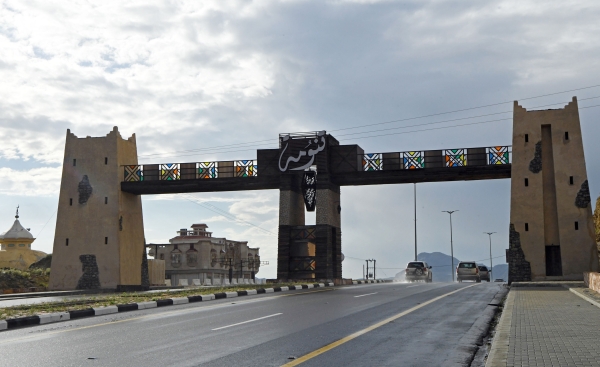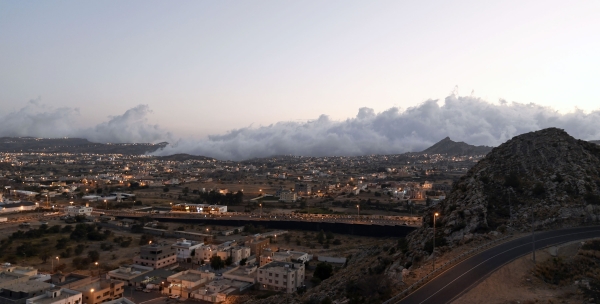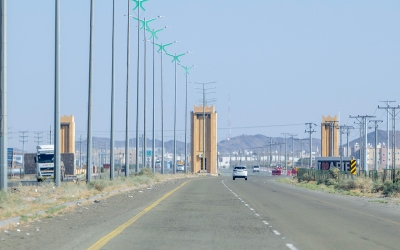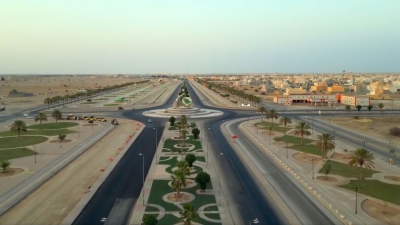

Tanumah Governorate is one of the governorates in Aseer Province, located on the heights of the Sarawat Mountains in the southwest of the Kingdom of Saudi Arabia. It lies within the Kingdom's moderate climate zone year-round. It is the second smallest population center in the province after al-Amwah Governorate, housing 0.9 percent of Aseer Province's population, with an estimated 17,756 residents according to the Saudi Census 2022. It is affiliated with the Mansebah Center.
Location of Tanumah Governorate
Tanumah Governorate is located in the central part of Aseer Province, approximately 119 km north of Abha City, the province's capital. It is bordered to the north by al-Namas Governorate, to the east by Bishah and Khamis Mushait Governorates, to the west by Bariq Governorate, and to the south by Abha City.
Tanumah Governorate is served by Abha Airport, the nearest airport to the city center, located 131 km away. It is an international airport with a current capacity of approximately 1.6 million passengers annually.
Highway No. Fifteen passes through the territory of the governorate and serves as the main land transportation route, providing the primary means of access to and from Tanumah.
Historically, Tanumah Governorate was located on the route of pilgrims and trade caravans, positioned at the crossroads of land routes.
Tanumah in Arabic poetry and literature
Tanumah holds a rich historical heritage, as it has been mentioned in pre-Islamic Arabic poetry. The poet Hajiz al-Azdi referenced it in his verse: "Wa Yawm Sabihna al-Hay Yawm Tanumah... Bi-Malmomat Yahwa al-Shuja' Wa'ideha." The historian al-Hamdani (893–945) mentioned Tanumah, stating: "Following the Sarat of 'Anaz is the Sarat of Hijr Bin al-Hano of al-Azd, with its towns being al-Jahwah, including Tanumah." He further added: "Tanumah, al-Ashjan, and Nihyan, then al-Jahwah are villages of Banu Rabiah Bin Hajr."
In the book "Tanumah: The Flower of the Sarawat" by Dr. Saleh Abu Arad, it is noted that: "The geographical region of Tanumah stretches from north to south with a width of approximately twenty-five km and from east to west with a length of about eighty km. This region is predominantly covered with dense forests, especially in the northern areas, where juniper trees dominate most of the highlands, along with species like al-Shath, al-Talh, and some types of grasslands."
Climate of Tanumah Governorate
Tanumah Governorate is approximately 2,300 m above sea level, which often results in it being surrounded by clouds. The climate is predominantly cold for most of the year, particularly during the winter season. The area frequently experiences fog and occasional snowfall.
Education in Tanumah Governorate
Tanumah Governorate has fifty schools spanning the three education levels: primary, intermediate, and secondary. It also hosts a technical college affiliated with the Technical and Vocational Training Corporation, offering diploma programs in Accounting Techniques and Computer Network Technology.
Mountains of Tanumah Governorate
Tanumah Governorate features mountainous elevations connected to the Sarawat Mountains, serving as a tourist attraction. Notable among these is the Man’a Mountain Range, named for its rugged terrain that only locals can navigate and adapt to. Other prominent mountains include Akran, al-Jarda, al-Farsh, Lenbash, Ghulamah, Atan, al-Manamah, Abdullah, Jalalah, al-Fatha, al-Qadiyah, al-Tawilah, al-Hammam, Isa, Al Soudah, and Mawmah.
The governorate has leveraged its mountains to attract climbing enthusiasts. In 2019, the Saudi Climbing and Hiking Federation, in collaboration with the Emirate of Aseer Province, organized climbing route events with participants from around the world.
During the rainy seasons, rocky waterfalls cascade from the mountains of Tanumah Governorate, particularly in the village of ad-Dahna' and the Man’a Mountains. The dams overflow with rainwater, and aromatic plants such as mint, jasmine, rosemary, basil, Artemisia, and wormwood flourish across fields, mountains, and valleys.
Archaeological inscriptions in Tanumah Governorate
The mountains of Tanumah Governorate are home to numerous monuments, including archaeological sites, ancient inscriptions, rock cavities, and sculptures formed over thousands of years due to erosion. Mount Akran features a towering rock mass with unique formations and a large cave overlooking the western side of the mountain. The mountain also houses an ancient mosque, consisting of a single stone structure without a roof, measuring approximately 7.5 m in length and 3.5 m in width. Near the mosque lies a large cave that penetrates the mountain. Below the cave’s entrance is a rock carving known as the "Hanash and Hayah," depicting a red serpent and a large black snake. Additional carvings and drawings in the area include ostriches, birds, horses, gazelles, camels, and other figures. The region also contains forts and castles of various shapes, some of which remain in good condition despite their age. Moreover, ancient pathways connect Tihama with the highlands, where carved footprints can still be seen on the rocks.
Tanumah Governorate is also known for its traditional carvings, decorations, and inscriptions found on the doors and windows of its homes, crafted from the wood of Acacia trees. These inscriptions showcase exceptional craftsmanship and intricate design methods. The doors and windows were further adorned with iron or copper alloys shaped into handles or rings in various forms. The carvings on the doors often reflected the homeowner’s social and economic status.
In 2018, Tanumah Governorate underwent an archaeological survey conducted by a scientific team from the (former) General Authority for Tourism and National Heritage. The survey covered sites with rock art and ancient Arabic inscriptions as part of efforts to register the archaeological inscriptions in the National Antiquities Register, ensuring their preservation and protection from encroachments.
Agriculture in Tanumah Governorate
The abundance of water has contributed to the flourishing agriculture in Tanumah Governorate. The Ghalibah Dam supplies water to the farms in the governorate. It is an earthen dam located in Tarj Valley, constructed in 2009 to harvest rainwater, raise groundwater levels in the valley's wells, and mitigate flooding. The dam has a storage capacity of 217,730 m, a length of 185 m, and a height of sixteen m. Farms in Tanumah also rely on rainwater stored by farmers in reservoirs, along with small dams scattered around the farms, as well as traditional wells. The mountains of Tanumah feature ancient agricultural terraces, established centuries ago to reclaim and cultivate the land.
The agricultural nature of Tanumah has contributed to the growth of agritourism in the governorate, with many farms offering wooden or glass cottages that attract visitors.
Tanumah's mountains and valleys are home to ancient trees, including Talqah (Sterculia africana), Hamar (Acacia etbaica), Jumayz (Ficus sycomorus), locally known as "al-Barayah," Aden (Adenium obesum), Sidr (Ziziphus spina-christi), Lebbek (Albizia lebbeck), and Raqa' (Commiphora gileadensis). Some of these trees bear fruit consumed by humans and animals. They also provide shade for residents and fields, and their branches are used in various industries, such as crafting natural beehives and building homes. They are also used in certain pharmaceutical industries.
Tanumah Governorate is surrounded by several forests, including Barmah, al-Abou'ah, al-Hifah, Sha’af Al Soudah, Wadi al-Ghur, Nazlat al-Qidhal, al-Sharaf, al-Mihfar, and Mawmah. Additionally, it features parks such as Shalal, al-Qamra, Tarj, Ghadhana, and Tarjas.
Agricultural crops in Tanumah Governorate
The farms in Tanumah Governorate produce various crops, including grains, vegetables, and fruits. Notably, the region is known for its year-round production of al-Shehri lemons (Meyer lemon). Other fruits include peaches, apricots, oranges, guavas, figs, pomegranates, grapes, mandarins, almonds, apples, pears, and plums. Additionally, the governorate cultivates wheat, millet, barley, cowpeas, and lentils. It is also known for its olive trees, al-Shat (Maytenus arbutifolia), al-Talh (Acacia gerrardii), juniper (Juniperus procera), and various types of wildflowers. It also features certain types of Japanese citrus fruits successfully cultivated in Tanumah.
Tomatoes are another significant agricultural product in the governorate. In 2023, the Agricultural Services Cooperative Association in al-Namas, in collaboration with Tanumah Governorate and the Aseer branch of the Ministry of Environment, Water, and Agriculture, organized the "Tomato Economics Forum." The forum included various workshops on tomato cultivation, ranging from traditional methods to economic approaches. It also featured panel discussions with experts in agricultural and economic fields, as well as an exhibition showcasing local tomato products.
Related quizzes
Related articles


